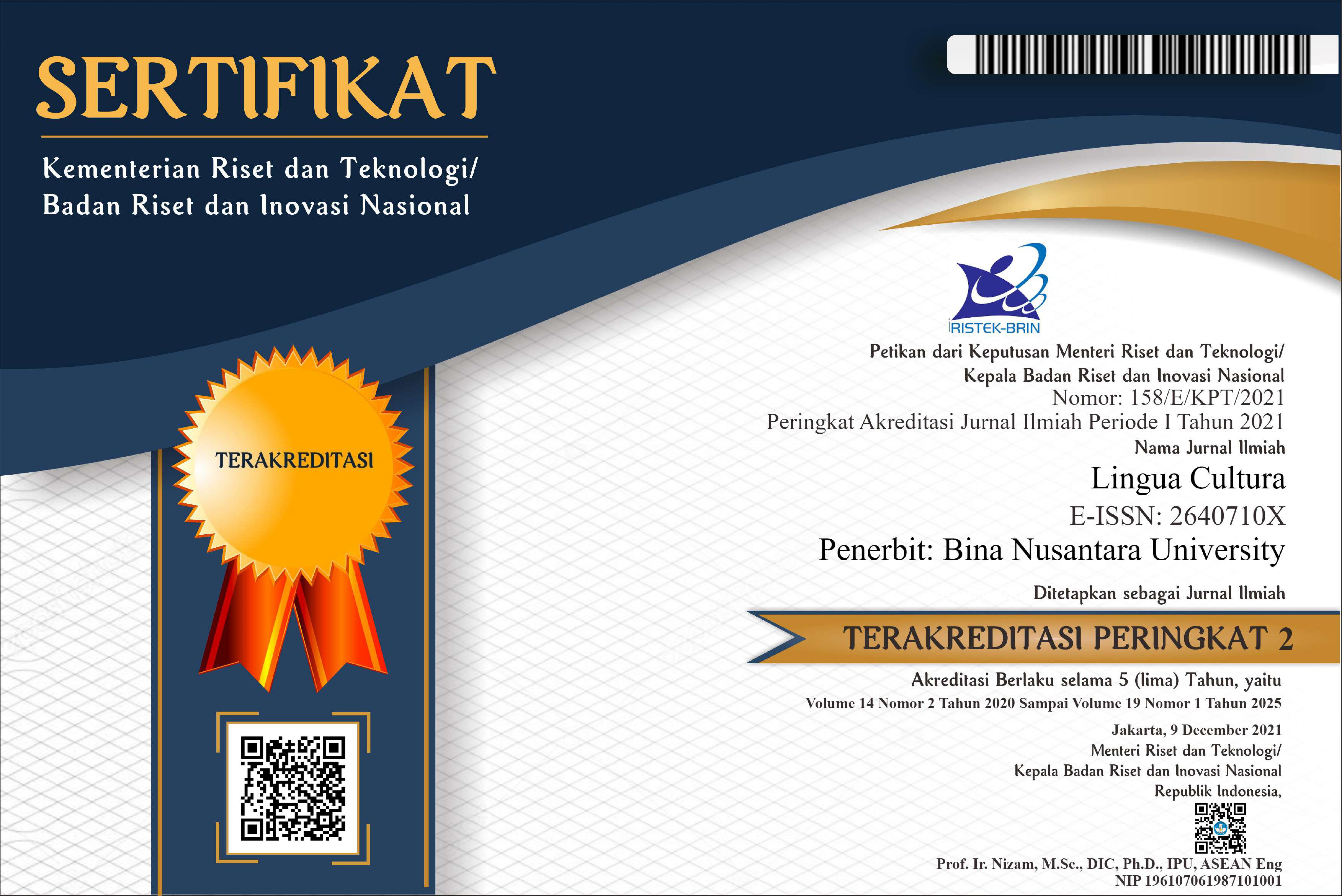Hegemonic Culture and Subaltern: A Compromised Veil in Indonesian Islamic Popular Novel
DOI:
https://doi.org/10.21512/lc.v11i1.1729Keywords:
hegemonic culture, subaltern, negotiation, contestation, Islamic novelAbstract
This research was based on the powerful function of the aesthetics in the society. Novel as an art work also functioned as an arena in which ideologies contest and negotiate. The research intended to show a mechanism underlining novel to have a significant hegemonic role. The material object was taken from Islamic popular novel namely “Ketika Mas Gagah Pergi dan Kembali”. The formal object was the negotiation of ideology which focused on the contact between intellectual and subaltern leading to the formation of a new compromised cultural practice. By applying the theory of hegemony in discussing the contestation and negotiation of ideologies in the novel, it is found that the contestation and negotiation between hegemonic and subaltern ideology lead to the occurrence of a compromise between the interest of the intellectual and the subaltern. The interest of the subaltern is based on the nostalgia of the past and fear or uncertain condition of future which lay in the domain of imagination that structures the novel.
Plum Analytics
References
Boelhower, W. Q. (1981). Antonio Gramsci’s Sociology of Literature. Contemporary Literature, 22(4), 574–599.
Fontana, B. (2005). The Democratic Philosopher: Rhetoric
as Hegemony in Gramsci. Italian Culture, 23(1), 97–123.
Gramsci, A. (1971). The Sellection of Prison Notebook. New York: International Publisher.
Gramsci, A. (2012). The Sellections from Cultural Writings. Chicago: Haymarket Books.
Green, M. (2006). Gramsci Cannot Speak: Presentation and
Interpretation of Gramsci’s Concept of Sublaternity. Rethinking Gramsci, 14(3), 1–24.
Hidayatullah, I. (2008). Sastra Populer Islami: Sebuah Negosiasi Budaya. Retrived from http://cabiklunik.blogspot.co.id/2008/03/sastra-ispolit-sebuahnegosiasi-budaya.html
Howson, R., & Smith, K. (2008). Hegemoni and the Operation of Consciousness and Ceorcion. In Consciousness and Coercion, 1–20. New York: Routledge.
Piliang, Y. A. (2011). Kuliah ke 3 Budaya Populer dan Agama. Retrieved February 10, 2010, from http://www.youtube.com/watch?v=z6K0bNl6FbU
Ronidin. (2016). Gerakan Sastra Keagamaan di Indonesia
Sesudah Reformasi 1988. Puitika, 12(1), 79–90.
Rosa, H. T. (2011). Ketika Mas Gagah Pergi dan Kembali.
Jakarta: AsmaNadia Publishing House.
Sakai, M. (2012). Preaching to Muslim youth in Indonesia :
the dakwah activities of Habiburrahman El Shirazy. RIMA: Review of Indonesian and Malaysian Affairs, 46(1), 9-13.
Smith, K. (2008). Hegemony, Subalternity, and Subjectivity
in Early Industrial Sydney. In R. Howson & K. Smith (Eds.), Hegemony Studies in Consensus and Coercion, 107–124. New York: Routledge.
Smith, K. (2010). Gramsci at the margins : subjectivity and
subalternity in a theory of hegemony. International Gramsci Journal, 1(2), 39–50.
Starobinski, J. & Kemp, W. S. (1966). The Idea of Nostalgia.
Diogenes, 14(54), 81–103.
Woolcock, J. A. (1985). Politics, Ideology and Hegemony in
Gramsci’s Theory. Social Economic Studies, 34(3), 199–210.
Zompetti, J. P. (1997). Toward a Gramscian critical rhetoric.
Western Journal of Communication, 61(1), 66–86.
Downloads
Published
Issue
Section
License
Authors who publish with this journal agree to the following terms:
a. Authors retain copyright and grant the journal right of first publication with the work simultaneously licensed under a Creative Commons Attribution License - Share Alike that allows others to share the work with an acknowledgment of the work's authorship and initial publication in this journal.
b. Authors are able to enter into separate, additional contractual arrangements for the non-exclusive distribution of the journal's published version of the work (e.g., post it to an institutional repository or publish it in a book), with an acknowledgment of its initial publication in this journal.
c. Authors are permitted and encouraged to post their work online (e.g., in institutional repositories or on their website) prior to and during the submission process, as it can lead to productive exchanges, as well as earlier and greater citation of published work.
USER RIGHTS
All articles published Open Access will be immediately and permanently free for everyone to read and download. We are continuously working with our author communities to select the best choice of license options, currently being defined for this journal as follows: Creative Commons Attribution-Share Alike (CC BY-SA)

















